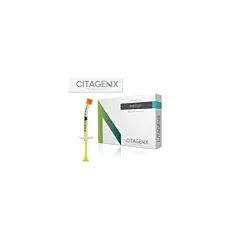Details
Raptos® Allograft Bone Particulates
Raptos® Allograft mineralized bone grafts offer an osteoconductive
platform for bone regeneration and Raptos demineralized particles offer
an osteoinductive boost. Used either alone or as part of a composite
bone graft, allograft bone particulates supply a natural framework
facilitating the attachment of osteogenic precursor cells.
Raptos® Allograft Premium Blend – This Cortical
Mineralized/Demineralized blend combines two of the most popular
allograft particles used in dentistry, all in a single syringe!
Features & Benefits
• Osteoconductive scaffold
• Remodels completely to host bone
• Mineralized graft material
Applications
• Mineralized component in a composite graft
• As a graft extender
• Osseous defects
Cancellous
- bone comes from the proximal and distal ends of the long bones, such
as the femoral head and condyles, proximal tibia, and humeral head.
Cortical - bone is manufactured from long bones such
as the femur, tibia, fibula, and humerus. Raptos offers the widest
range of particulate sizes in cortical to suit your dental application.
Cortico-cancellous - bone comes from sections of the
illium which are ground into several particulate sizes. The blend of
cortical and cancellous that results from this process gives this
product the structure of cortical, with the open scaffolding for bone to
grow into offered by cancellous.
Demineralized - cortical bone is made by placing cortical bone particulates in an acid solution to remove most of the calcium from the bone.
Premium Blend - This Cortical
Mineralized/Demineralized blend combines two of the most popular
allograft particles used in dentistry, all in a single vial!
Safety informations
Each donor is thoroughly evaluated using medical/social history
questions, medical records, blood tests, culture results, physical
examination and autopsy reports (when performed). This process is used
to ensure the donor is suitable for donation by allowing to recognize
and exclude potential diseases or medical conditions that are
unacceptable.
Specific lab tests are performed for Syphilis, Hepatitis B and C, HIV
and other viruses. All of the donor chart information is evaluated by
individuals trained in tissue banking, prior to the processing of the
tissue.
Tissue grafts are rinsed and soaked in various solutions to minimize
transmission of bacteria and viruses. Processing and packaging of the
tissue are performed using aseptic technique and occur in a clean room.
As an added margin of safety, a low dose gamma irradiation after final packaging of the musculoskeletal grafts is utilized.
AATB accredited source and mandatory CTO registered with Health Canada.
Returns
Return Policy for Medical Products
At Linen Plus, we prioritize the safety and satisfaction of our customers. Due to the sensitive nature of medical products, our return policy is designed to ensure the highest standards of hygiene and quality.
Non-Returnable Items:
All medical products are non-returnable unless they are defective or expired. This policy helps us maintain strict health and safety standards, ensuring that every product you receive is in pristine condition.
Defective or Expired Products:
If you receive a product that is defective or has expired, we are committed to resolving the issue promptly. Please contact our customer service team for assistance.
How to Request a Return for Defective or Expired Products:
-
Contact Us: Send an email to our customer service team at [email protected]. Please include your order number, a description of the issue, and any relevant photos, if applicable.
-
Assessment: Our customer service team will assess the information provided and may request additional details if necessary.
-
Return Authorization: If the product is confirmed to be defective or expired, you will receive a return authorization along with instructions on how to return the item.
-
Replacement or Refund: Once we receive the returned item, we will process a replacement or a refund, depending on your preference and product availability.
Important Notes:
All medical product return requests must be made within 7 days of receiving the product.
Only products that are defective or expired will be eligible for return.
Please ensure the product is securely packaged for return to avoid any damage during transit.
Thank you for your understanding and cooperation. We provide you with high-quality products and exceptional customer service. If you have any questions or need further assistance, please do not hesitate to reach out to us at [email protected]






